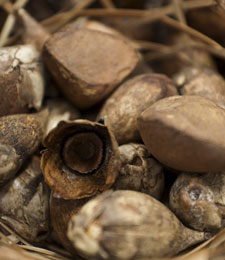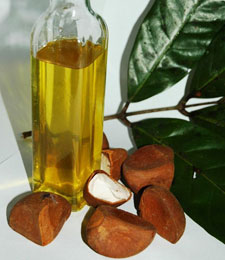Our products
Andiroba
Carapa guianensis
PRESENTATION
Andiroba oil is one of the most widely used natural oils in the Amazon. Andiroba trees have straight trunks that can reach a height of 30 meters. The name comes from the Tupi Guarani language and means ‘bitter oil’. Several scientific studies have proven its popular use.
This vegetable oil has numerous virtues, including anti-inflammatory and analgesic properties that have a positive effect on rheumatism, skin lesions and psoriasis. In addition, its bitterness scares away insects and parasites, making it suitable for use as a repellent or against lice.
Analgesic, antibacterial, anti-inflammatory and anti-allergic action
BENEFITS FOR THE SKIN
Andiroba oil can be used pure or in the formulation of cosmetic products. It soothes muscle and joint pain thanks to its warming and relaxing action in contact with the skin. It reduces the formation of cellulite by repairing damaged tissues and has a mild sun protection effect. Andiroba-based products can be used as a massage oil with soothing and relaxing properties, before and after physical exertion, as a treatment for skin conditions.
Fatty acid composition % | |
Palmitic acid (C16:0) | 27 |
Palmitoleic acid (C16:1) | 1 |
Stearic acid (C18:0) | 9 |
Oleic acid (C18:1) | 52 |
Linoleic acid (C18:2) | 9 |
Linoleic acid (C18:3) | 2 |
Andiroba oil contains limonoids - highly oxygenated and modified terpenoids. Limonoids are known for their diverse biological activities such as insecticides, antifeminants, antibacterials, antimalarials and antivirals.
The most abundant limonoids were gedunin, 6α-acetoxygedunin, 7-desacetoxy-7-oxogedunin and methyl angolensate.
Squalene, stigmasterol and cholesterol are also found in small quantities. Phragmaline of the mexicanolide type, known collectively as carapanolides, have also been isolated from the seeds and oil. Other compounds include triterpenes (ursolic acid), flavonoids (naringenin), coumarins (scopoletin), benzoic acid derivatives (3,4 and 2,6-dihydroxymethyl) and palm oil derivatives (2,6-dihydroxymethylbenzoate) and long-chain fatty acids (tetra-triacontanoic acid (34:0) and triacontanoic acid (30:0).






